
Table of Contents
In a rush?
Download the PDF for later
Introduction
Amazing customer experiences are delivered at the intersection of product management and customer success & support. Product management relies on success and support to handle customer needs and report back news from the front lines. Success and support, meanwhile, need product management to advocate on their customers’ behalf on feature prioritization, bug fixes, and other product improvements. To make sure this key partnership is running smoothly, it can be necessary to perform an alignment check.
Below, we’ve reprinted a section of our recent publication, the “Product Manager’s Influence Map.” While the whole piece outlines the relationship between product management and each department in an organization, we’ve excerpted a section focusing on the interaction with customer success and support to call special attention to this important relationship. Read more to understand how an effective relationship between product and customer-facing teams can lead to greater product success.
Methodology & Definitions
We’ve identified eight key roles in the organization that product managers in nearly every company will interact with on a regular basis. Depending on the nature of the business and the market that the product is targeting, some of these functions might be more important or more impactful than others—for example, in a B2C business, the marketing team will have much more power and influence than in a B2B context, in which case sales might be one of the strongest driving forces in the organization.
- Business Operations
- Customer Success
- Engineering
- Finance
- Human Resources
- Marketing
- Sales
- Technical Support
You will note that C-level executives are not included in this list; we determined that the relationship between product management and these roles is unique and as a result falls outside of this model. We’ll describe that relationship separately.
Each of these eight key stakeholder groups was then plotted against the axes of functional distance and workflow dependency:
- Functional Distance: How closely aligned is the job role with the core duties and responsibilities of a product manager? How do their goals, KPIs/OKRs, and reporting structure relate to and align with those of product management?
- Workflow Dependency: How much impact can the work done (or not done) by the people in this role have on the success of the efforts of a product manager? Are there responsibilities typically associated with this role that can constrain or block a product, feature, or improvement from being successfully released to the market?
Based on their score against each of these axes, the groups have been assigned to one of four quadrants of influence and concern:
Critical Supporters: Roles that are both functionally close to the product manager and upon whom the product manager depends greatly to deliver their product to market; relationships with these stakeholders must be managed closely and carefully to ensure that the teams are tightly aligned with one another on a daily basis.
Accelerators: Roles that are functionally close to the product manager but whose work streams and workflows are largely independent of the product manager’s work to bring a product to market; these are teams whose alignment with the product management team can accelerate business goals, but where a lack of strong alignment may not diminish the ability to deliver quality product to the market.
Potential Disruptors: Roles that are not functionally close to the product manager, but whose priorities and motivations can severely impact the ability of the product manager to successfully deliver products to market; these are the teams with whom product managers may struggle at times to build a strong and reliable relationship, but whose alignment to the goals of the product team can be essential to success.
Outliers: Roles that are neither functionally close to the product manager, nor do they create strong dependencies for product success; these teams may have some impact on the periphery of the product manager’s role, and they are often influencers within the organization as a whole, but their direct day-to-day work will have little impact on the success of a product being brought to market.
In each chapter to follow, these groups will be described in further detail, along with suggestions on how a new product manager might approach each of them with an eye toward building a strong, lasting relationship that
maximizes the likelihood of success in bringing new products, features, or enhancements to market.



Accelerators
There are many teams in any organization which seem on their surface to be functionally close to product management, but whose work is often largely independent of the day-to-day operations of the product management team. While these accelerators can often succeed on their own merits, it is always a good idea for product management to maintain
close alliances with them, as their work can have large impacts on the success of a product in the market.
IDENTIFYING ACCELERATORS
The defining characteristic of an accelerator is their independence within the company, particularly from the product management team itself. They tend to have very specific objectives, goals, and KPIs that apply to their efforts but do not cross over onto other teams.
While some of their work may depend on other teams, they can largely sustain and support themselves, especially when provided with the right resources and budget. These are teams who more often provide indirect feedback into the product organization, and who take the results of that organization as they are and work with them as they can.
For example, technical support teams are often almost entirely self-organizing and self-sustaining, and while they can do their jobs better with direct collaboration with product management, they can also often be highly successful with only a modicum of interaction. Technical support teams typically focus their KPIs and metrics around things such as call volumes, wait times, time to resolve, and a narrow view of customer satisfaction—most of which only clearly apply within the world of a support organization.
Similarly, recent years have seen the rise of customer success organizations, which provide a service somewhere between sales and support, helping new customers to achieve success with the product in early days, and ensuring that the concerns of long-time customers are heard and addressed. Their success is measured by customer retention
rates, and growth of existing customer relationships. While customer success and product might share a high-level KPI in NPS or other measures of overall satisfaction, the focus of customer success organizations tends to be much more specific than the macro view that product takes—more focused on the individual customer needs than the broader, market-level view of the strategy and tactics of the company, although both organizations are ultimately measured on product revenue.
Customer Success as an Accelerator
Although a relatively new role in organizations, the concepts and building blocks of the customer success organization have existed in organizations for decades—implementation teams, service organizations, even pre-sales
and post-sales technical teams. These separate functions have begun to be folded into a single structure in recent years, combining all of these independent teams under one umbrella of “customer success.”
Because these teams typically engage with customers immediately following the sale of a product, platform, or service, they tend to operate independently of other teams in the organization. They are still a font of knowledge about how customers interact with the systems that we build as product managers, similar in some ways to support but often with a very different angle—while support is helping customers with their problems, customer success is very often engaged directly with the customer to avoid problems in the first place.
These teams tend to be high-touch in initial implementations, particularly in B2B contexts, and maintain open channels of communication with customers as the services side of the engagement winds down and hands the reins over to the customer themselves. At the same time, customer success has long-term goals with our customers and our users, beyond just the initial implementation—they act as trusted advisors throughout the customer lifecycle to ensure high levels of customer adoption, satisfaction, and ultimately retention. This is particularly important when new product
features or capabilities are released, as the high-touch approach that customer success provides can allow us early insight into any iterative changes that might be needed. Customer success can be an exceptionally powerful partner, and act as an accelerator to our product team goals.
GOALS & RESPONSIBILITIES
- Engage with customers early and often to set them up for long-term success.
- Manage customer relationships after sales has completed their work, throughout the lifecycle of the customer
- Identify and engage at-risk customers to prevent churn.
- Identify and close opportunities for customer growth or upsell.
- Assist customers with initial integration work, proofs of concept, and user acceptance testing.
- Escalate issues from customers into prioritization and planning efforts.
NEEDS FROM PRODUCT MANAGEMENT
- New release preparation—training, documentation, previews, FAQs.
- Access to known issues and workarounds.
- Consultations on high-profile or high-impact issues.
- Means to escalate major issues or concerns into prioritization & planning particularly based on LTV.
- Clear articulation of vision and strategy, insight into prioritization decisions.
COMMON ALIGNMENTS
- Focus on the successful implementation and use by the customer.
- Clear understanding of the differences between buyer personas and end-user personas.
- Establishment and maintenance of long-term successful customer relationships
COMMON MISALIGNMENTS
- Very focused on individual cases or certain profiles of customers.
- May take short-term shortcuts to satisfy customers with long-term negative effects.
- Customer success teams with their own technical resources sometimes make product changes that are not clearly communicated, documented, or reviewed with the product team.
- Without clear understanding of priorities, can make promises to customers that don’t align with product management’s plans.
- Poor communication or training on new features can inhibit customer adoption.
WAYS TO CREATE ALIGNMENT
- Join customer update calls or on-site visits.
- Ensure that issues or concerns are heard and escalated into prioritization and planning.
- Understand the processes, services, and tools used by the customer success teams.
- Actively engage on proofs of concept or other technical work being done to support customers’ goals.
- Share insights into highest LTV customers, segments, and personas.